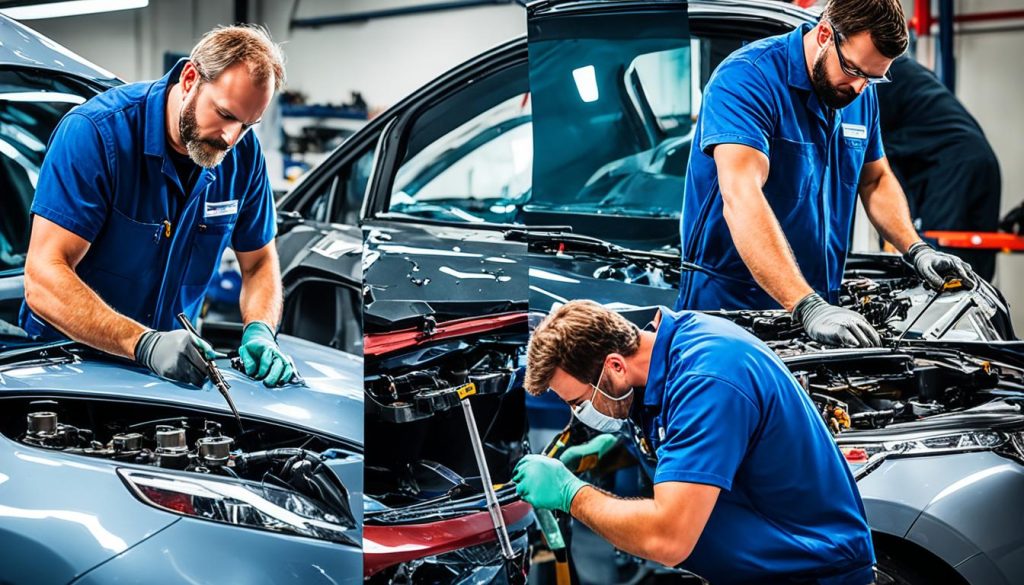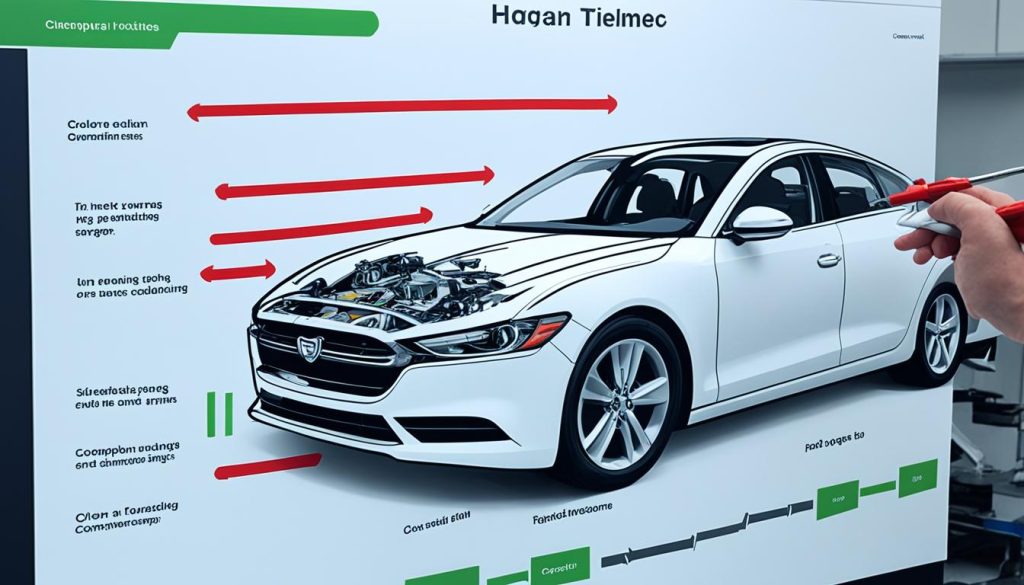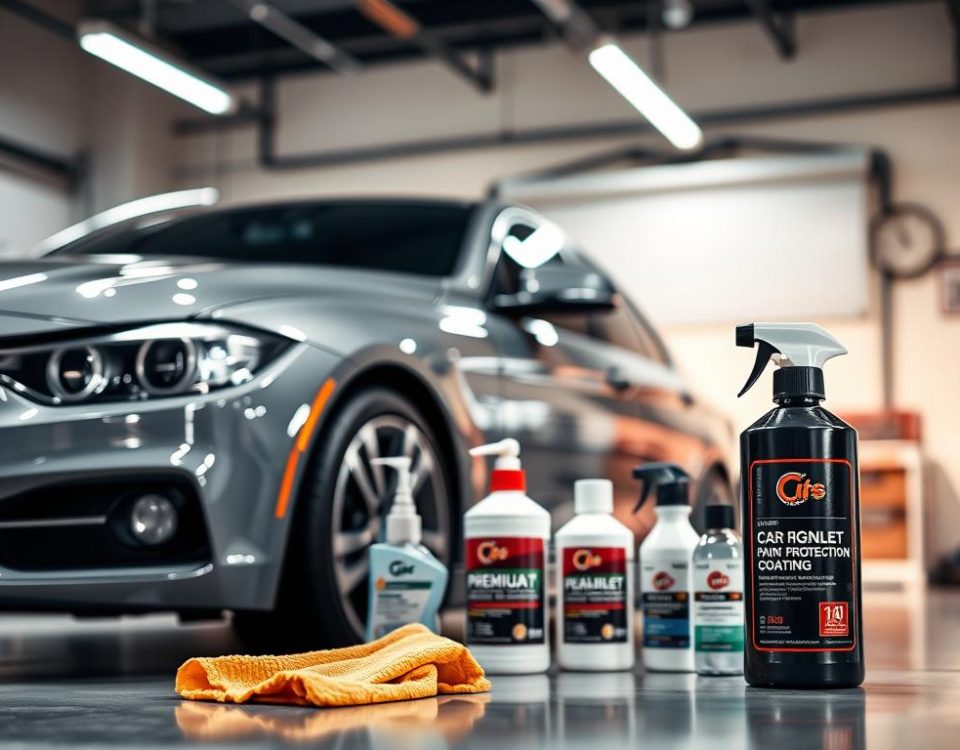
Real Customer Stories: How We Helped with Their Collision Repair Needs

OEM vs Aftermarket Parts: What’s Best for Your Vehicle Repair?
Having a car in the auto body shop can be a stressful hassle, especially if you have to find alternate transportation. The amount of time you’ll have to wait for your car to be repaired can vary greatly depending on the severity of the damage, type of car, insurance claims, and more. Understanding the collision repair process and repair timeline can help you manage your expectations and plan accordingly. This guide will cover the average repair times for different types of damage, the stages of the collision repair process, and the key factors that influence repair scheduling.
Key Takeaways
- The duration of collision repair can range from a few days to several weeks, depending on the severity of the damage.
- Minor collisions typically involve faster repairs, while major damage can take significantly longer to fix.
- The repair process involves multiple stages, including assessment, insurance approval, parts ordering, body work, and quality control.
- Factors like part availability, vehicle type, and insurance company involvement can impact the overall repair timeline.
- Proactive communication, prompt decision-making, and scheduling during non-peak periods can help streamline the repair process.
Average Collision Repair Time
The average time required for collision repair can vary significantly, depending on the severity of the damage. Understanding these timelines can help you plan and set realistic expectations for your vehicle’s restoration.
Minor Collision Repair
Minor collision repairs, such as dents, scratches, or minor panel damage, typically take between 1 to 3 days to complete. These types of repairs often involve simple fixes, like paintless dent repair or minor panel replacements, which can be done relatively quickly.
Major Collision Repair
In contrast, major collision repairs involving structural damage, frame straightening, or a complete repaint can take 1 to 3 weeks or longer to finish. Significant repairs require more extensive work, including disassembly, replacement of multiple parts, and a thorough refinishing process.
Repair Timeline by Part Type
The replacement of specific vehicle parts also has its own estimated timelines:
- Bumper repairs: 1-2 days
- Fender repairs: 2-4 days
- Door repairs: 2-4 days
- Windshield replacement: 1 day
These part-specific timelines can provide a general idea of the average repair time for your collision repair needs, whether it’s minor damage or major damage requiring part replacement.
Stages of the Collision Repair Process
The collision repair process involves several critical stages, each playing a vital role in restoring your vehicle to its pre-accident condition. Let’s explore the key steps in this comprehensive process:
Assessment and Estimation
The first step in the repair process is a thorough assessment of the damage. The repair facility will carefully examine your vehicle, documenting the extent of the collision’s impact. This comprehensive evaluation is used to provide an accurate repair estimate, which can take several hours to a day to complete.
Insurance Approval
If your collision is covered by insurance, the next step is to obtain approval for the repair estimate. This process typically takes 3-5 days, as the insurance provider reviews the assessment and ensures the proposed repairs are justified and in line with industry standards.
Ordering and Receiving Parts
Once the repair estimate is approved, the repair facility will order any necessary replacement parts. This parts procurement process can add 1-2 hours to 1-2 days to the overall timeline, depending on part availability and delivery times.
Body Repair and Painting
With the parts in hand, the repair technicians can begin the body work and painting. Depending on the severity of the collision damage, this stage can take anywhere from 1 day to 4 weeks to complete.
Reassembly and Quality Control
The final step in the repair process stages is the reassembly and quality control inspection. The vehicle is carefully put back together, and a thorough inspection is conducted to ensure the body work and final inspection meet the highest standards. This final stage is typically completed within a day.
By understanding the various stages of the collision repair process, you can better anticipate the timeline and work closely with your repair facility to streamline the parts procurement and insurance approval steps, ultimately getting your vehicle back on the road as soon as possible.

Factors Affecting Repair Time Estimates
When it comes to collision repair, several key factors can significantly impact the estimated timeline for getting your vehicle back on the road. Understanding these variables is crucial in setting realistic expectations and navigating the repair process efficiently.
Severity of Damage
The primary factor influencing repair time is the severity of the damage to your vehicle. Minor dents and scratches can often be addressed relatively quickly, whereas major structural repairs or extensive body work may require a more extensive timeline. The more complex the damage, the longer the repair process can take.
Availability of Replacement Parts
The availability of necessary replacement parts is another crucial factor. If your vehicle requires specialized or hard-to-find components, especially for older or imported models, the parts ordering and delivery process can add significant delays to the overall repair timeline. Maintaining open communication with your repair shop is essential to understand part lead times.
Type of Vehicle
The type of vehicle you own can also affect the repair time. Luxury, high-end, or imported cars may require more specialized tools, equipment, and technical expertise, which can extend the repair process compared to more standard domestic models. Additionally, the availability and cost of parts for these vehicles can further impact the timeline.
Insurance Company Involvement
If your collision repair is covered by an insurance claim, the claims review and approval process can add several days to the overall timeline. Ensuring prompt communication and decision-making with your insurance provider can help streamline this stage of the repair journey.
Repair Shop Workload
Finally, the current workload and capacity of the repair shop can influence the timeline. Shops with a high volume of concurrent projects may have longer turnaround times, whereas those with more availability can often complete the work more efficiently. Discussing the shop’s current workload can help set realistic expectations for your vehicle’s repair timeline.
By understanding these key factors affecting repair time estimates, you can better plan and navigate the collision repair process, ensuring your vehicle is back on the road as quickly as possible.
Understanding Repair Timelines
Navigating the collision repair process can be challenging, but understanding the typical repair timelines can help manage your expectations and plan accordingly. The duration of collision repairs can vary greatly, ranging from a few hours for minor touch-ups to several weeks for major structural damage. By knowing what to expect, we can better prepare for the disruption to our daily routines.
The key factors that influence repair timelines include the severity of the damage, the availability of replacement parts, the type of vehicle, the insurance company’s involvement, and the repair shop’s workload. Staying informed about these variables can help us set realistic expectations and make informed decisions during the repair process.
Factors that Affect Repair Timelines
- Severity of Damage – Minor dents and scratches can often be repaired more quickly than major structural damage.
- Availability of Replacement Parts – If a part needs to be ordered, it can add significant time to the repair process.
- Type of Vehicle – Specialty or high-end vehicles may require more specialized parts and labor, extending the repair timeline.
- Insurance Company Involvement – The claims approval process and negotiations with the insurance provider can impact the overall timeline.
- Repair Shop Workload – Busy repair shops may have longer wait times for scheduling and completing the work.
By understanding these factors, we can better manage our expectations and work closely with the repair shop and insurance provider to streamline the process and minimize disruptions to our daily lives.

Streamlining the Repair Process
When it comes to collision repair, the repair shop will play a crucial role in determining the timeline. However, there are steps you can take to help streamline the process and minimize delays. By maintaining proactive communication, making prompt decisions, and scheduling repairs during non-peak periods, you can work collaboratively with the repair facility to expedite the repair timeline and get your car back on the road as soon as possible.
Proactive Communication
Staying in close contact with the repair shop is essential for streamlining the streamlining repair process. Provide the technicians with all the necessary information upfront, respond promptly to their inquiries, and keep an open dialogue throughout the repair process. This proactive communication can help ensure that any potential issues or delays are addressed quickly, allowing the repair to progress smoothly.
Prompt Decision-making
When the repair shop requires your input or approval, it’s crucial to make decision-making in a timely manner. Prompt decision-making can help avoid delays and keep the repair process moving forward efficiently. By being responsive and decisive when needed, you can help the technicians focus on the task at hand and complete the work as quickly as possible.
Schedule During Non-peak Periods
- If possible, try to schedule your collision repair during the repair shop’s scheduling non-peak periods.
- This can mean avoiding busy seasons, such as the summer months or holiday periods, when the shop may be inundated with other customer vehicles.
- By scheduling your repair during a less busy time, the technicians can dedicate more time and attention to your vehicle, potentially expediting the streamlining repair process.
By taking these steps, you can work hand-in-hand with the repair shop to streamline the collision repair process and get your vehicle back on the road as soon as possible.
Repair Time Estimates: A Case-by-Case Basis
When it comes to collision repair, it’s important to understand that repair time estimates are done on a case-by-case basis. Each collision and vehicle is unique, so the actual repair duration for your vehicle will depend on the specific circumstances. While industry averages and common timelines can provide a general guideline, the repair shop will assess the full extent of the damage and provide you with a tailored estimate based on the required repairs, parts availability, and their current workload.
To ensure you have the most up-to-date information on the timeline for your vehicle’s collision repairs, it’s crucial to stay in close communication with the repair facility throughout the process. This individualized approach will help you understand the specific factors that are influencing the repair time estimates for your vehicle.
By understanding that repair time estimates are a case-by-case process, you can set realistic expectations and work closely with the repair shop to minimize any delays or unexpected complications. This open communication and tailored approach will help you navigate the collision repair journey with confidence.
Conclusion
Collision repairs can be a complex and disruptive experience, but by understanding the process and the factors that influence repair timelines, we can better manage our expectations and plan accordingly. From the average repair time for minor and major damages to the intricate stages of the collision repair process, we’ve explored the details that can impact the overall timeline for getting our vehicle back on the road.
By maintaining proactive communication with our repair facility, making prompt decisions, and scheduling repairs during non-peak periods, we can help streamline the process and minimize delays. It’s important to remember that repair time estimates are done on a case-by-case basis, so staying in close contact with our repair shop is crucial to ensure we have the most up-to-date information on the timeline for our specific collision repairs.
As we conclude, the key takeaways are clear: collision repairs may take anywhere from a few hours to several weeks, depending on the severity of the damage, parts availability, vehicle type, insurance involvement, and the repair shop’s workload. By understanding these factors and taking an active role in the process, we can navigate the collision repair journey with confidence and get back on the road as soon as possible.



